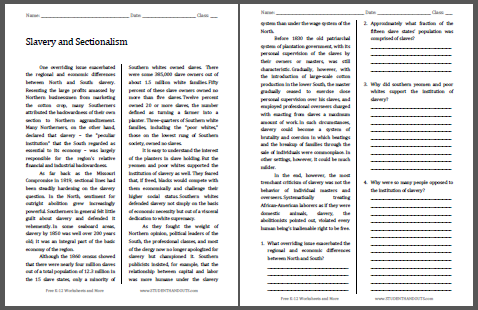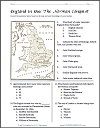Slavery and Sectionalism |
|
One overriding issue exacerbated the regional and economic
differences between North and South: slavery. Resenting the
large profits amassed by Northern businessmen from marketing the
cotton crop, many Southerners attributed the backwardness of
their own section to Northern aggrandizement. Many Northerners,
on the other hand, declared that slavery – the "peculiar
institution" that the South regarded as essential to its economy
– was largely responsible for the region's relative financial
and industrial backwardness.
Although the 1860 census showed that there were nearly four
million slaves out of a total population of 12.3 million in the
15 slave states, only a minority of Southern whites owned
slaves. There were some 385,000 slave owners out of about 1.5
million white families. Fifty percent of these slave
owners owned no more than five slaves. Twelve percent
owned 20 or more slaves, the number defined as turning a farmer
into a planter. Three-quarters of Southern white families,
including the "poor whites," those on the lowest rung of
Southern society, owned no slaves. It is easy to understand the interest of the planters in
slave holding. But the yeomen and poor whites supported
the institution of slavery as well. They feared that, if freed,
blacks would compete with them economically and challenge their
higher social status. Southern whites defended slavery not
simply on the basis of economic necessity but out of a visceral
dedication to white supremacy. As they fought the weight of Northern opinion, political
leaders of the South, the professional classes, and most of the
clergy now no longer apologized for slavery but championed it.
Southern publicists insisted, for example, that the relationship
between capital and labor was more humane under the slavery
system than under the wage system of the North. Before 1830 the old patriarchal system of plantation
government, with its personal supervision of the slaves by their
owners or masters, was still characteristic. Gradually,
however, with the introduction of large-scale cotton production
in the lower South, the master gradually ceased to exercise
close personal supervision over his slaves, and employed
professional overseers charged with exacting from slaves a
maximum amount of work. In such circumstances, slavery
could become a system of brutality and coercion in which
beatings and the breakup of families through the sale of
individuals were commonplace. In other settings, however,
it could be much milder. In the end, however, the most trenchant criticism of slavery was not the behavior of individual masters and overseers. Systematically treating African-American laborers as if they were domestic animals, slavery, the abolitionists pointed out, violated every human being's inalienable right to be free. |
Click here to print. |
Text courtesy of the U.S. State Department, Bureau of International Information Programs, 2005 |


 As far back as the Missouri Compromise in 1819, sectional
lines had been steadily hardening on the slavery question. In
the North, sentiment for outright abolition grew increasingly
powerful. Southerners in general felt little guilt about
slavery and defended it vehemently. In some seaboard
areas, slavery by 1850 was well over 200 years old; it was an
integral part of the basic economy of the region.
As far back as the Missouri Compromise in 1819, sectional
lines had been steadily hardening on the slavery question. In
the North, sentiment for outright abolition grew increasingly
powerful. Southerners in general felt little guilt about
slavery and defended it vehemently. In some seaboard
areas, slavery by 1850 was well over 200 years old; it was an
integral part of the basic economy of the region.









